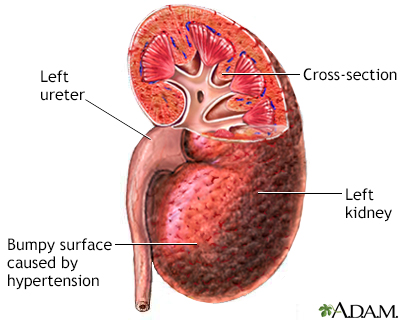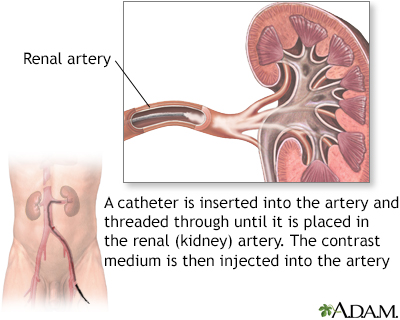Pregnancy SmartSiteTM
Renal hypertension; Hypertension - renovascular; Renal artery occlusion; Stenosis - renal artery; Renal artery stenosis; High blood pressure - renovascular DefinitionRenovascular hypertension is high blood pressure due to narrowing of the arteries that carry blood to the kidneys. This condition is also called renal artery stenosis. CausesRenal artery stenosis is a narrowing or blockage of the arteries that supply blood to the kidneys. The most common cause of renal artery stenosis is a blockage in the arteries. This problem most often occurs when a sticky, fatty substance called plaque builds up on the inner lining of the arteries, causing a condition known as atherosclerosis. When the arteries that carry blood to your kidneys become narrow, less blood flows to the kidneys. The kidneys mistakenly respond as if your blood pressure is low. As a result, they release hormones that tell the body to hold on to more salt and water. This causes your blood pressure to rise. Risk factors for atherosclerosis:
Fibromuscular dysplasia is another cause of renal artery stenosis. It is typically seen in women under age 50. It tends to run in families. The condition is caused by abnormal growth of cells in the walls of the arteries leading to the kidneys. This also leads to narrowing or blockage of these arteries. SymptomsPeople with renovascular hypertension may have a history of very high blood pressure that is hard to bring down with medicines. Symptoms of renovascular hypertension include:
If you have a dangerous form of high blood pressure called malignant hypertension, symptoms can include:
Exams and TestsThe health care provider may hear a "whooshing" noise, called a bruit, when placing a stethoscope over your belly area where the renal arteries are. The following blood tests may be done:
Imaging tests may be done to see if the kidney arteries have narrowed. They include:
TreatmentHigh blood pressure caused by narrowing of the arteries that lead to the kidneys is often hard to control. One or more medicines are needed to help control blood pressure. There are many types available.
Have your cholesterol levels checked, and treated if it is needed. Your provider will help determine the right cholesterol levels for you based on your heart disease risk and other health conditions. Lifestyle changes are important:
Further treatment depends on what causes the narrowing of the kidney arteries. Your provider may recommend a procedure called angioplasty with stenting. These procedures may be an option if you have:
However, the decision about which people should have these procedures is complex, and depends on many of the factors listed above. Possible ComplicationsIf your blood pressure is not well controlled, you are at risk for the following complications:
When to Contact a Medical ProfessionalMake an appointment with your provider if you think you have high blood pressure. Contact your provider if you have renovascular hypertension and symptoms get worse or do not improve with treatment. Also make contact if new symptoms develop. PreventionPreventing atherosclerosis may prevent renal artery stenosis. Taking the following steps can help:
ReferencesBakris GL, Sorrentino MJ. Systemic hypertension: mechanisms, diagnosis, and treatment. In: Libby P, Bonow RO, Mann DL, Tomaselli GF, Bhatt DL, Solomon SD, eds. Braunwald's Heart Disease: A Textbook of Cardiovascular Medicine. 12th ed. Philadelphia, PA: Elsevier; 2022:chap 26. Flack JM. Arterial hypertension. In: Goldman L, Cooney KA, eds. Goldman-Cecil Medicine. 27th ed. Philadelphia, PA: Elsevier; 2024:chap 64. Textor SC. Renovascular hypertension and ischemic nephropathy. In: Yu ASL, Chertow GM, Luyckx VA, Marsden PA, Skorecki K, Taal MW, eds. Brenner and Rector's The Kidney. 11th ed. Philadelphia, PA: Elsevier; 2020:chap 47. US Preventive Services Task Force, Krist AH, Davidson KW, Mangione CM, et al. Screening for hypertension in adults: US Preventive Services Task Force Reaffirmation Recommendation Statement. JAMA. 2021;325(16):1650-1656. PMID: 33904861 pubmed.ncbi.nlm.nih.gov/33904861/. | ||
| ||
Review Date: 5/10/2024 Reviewed By: Neil Grossman, MD, Saint Vincent Radiological Associates, Framingham, MA. Review provided by VeriMed Healthcare Network. Also reviewed by David C. Dugdale, MD, Medical Director, Brenda Conaway, Editorial Director, and the A.D.A.M. Editorial team. View References The information provided herein should not be used during any medical emergency or for the diagnosis or treatment of any medical condition. A licensed medical professional should be consulted for diagnosis and treatment of any and all medical conditions. Links to other sites are provided for information only -- they do not constitute endorsements of those other sites. No warranty of any kind, either expressed or implied, is made as to the accuracy, reliability, timeliness, or correctness of any translations made by a third-party service of the information provided herein into any other language. © 1997- A.D.A.M., a business unit of Ebix, Inc. Any duplication or distribution of the information contained herein is strictly prohibited. | ||


 Hypertensive kidne
Hypertensive kidne Renal arteries
Renal arteries
